Researchers Still Uncertain About the Techniques Used to Create the Monolithic Rock-Hewn Churches 800 Years Ago.
Located in the Amhara region of Ethiopia, approximately 600 kilometers north of the capital Addis Ababa, lies a famous yet mysterious town known as Lalibela. At the heart of this town is a UNESCO World Heritage site comprising 11 churches carved from solid rock.
The complex is believed to date back to the Zagwe dynasty during the reign of King Lalibela (1181 – 1221), who aimed to establish a “New Jerusalem” on African soil accessible to all Ethiopian citizens. The names and characteristics of the churches evoke structures in Jerusalem, such as the Church of Golgotha and the Tomb of Adam. Here, in the 13th century, devout Christian followers began chiseling red volcanic rock to “build” 13 churches.
The architecture of the rock-hewn churches in the small town of Lalibela stands as the most unique testament to Ethiopia’s distinct cultural traits— a country rich in ethnic diversity with many unique and fascinating traditions.
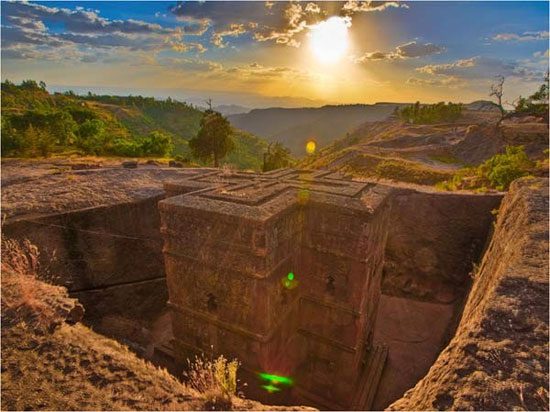
Lalibela Church at Sunset.
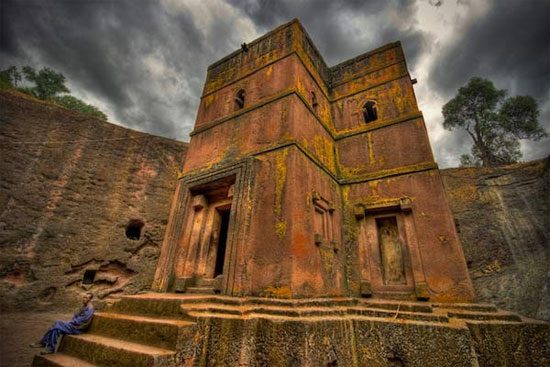
Weathered Rock Faces Over Time.
Archaeologists have uncovered much about the history of the complex, yet questions remain unanswered, one of which is how these churches were constructed. How did the ancient Ethiopians manage to create this complex wonder with the limited tools and techniques available at that time?
The 11 monolithic churches of Lalibela are divided into two main groups: the northern group consists of 6 churches, while the southern group comprises 4 churches. The remaining church, Bet Giorgis or St. George, stands separately, a short distance from the main groups.
The churches are interconnected by a labyrinth of tunnels and pathways, each with a unique design and layout. They are characterized by impressive rock-cut architecture, with some structures featuring intricate facades, columns, and archways. The interiors are equally stunning, adorned with exquisite carvings, murals, and religious artifacts.
The rock-hewn church complex in Lalibela is one of the largest monolithic structures in the world. The largest church, Bet Medhane Alem, stands 10 meters tall, 33 meters long, and 22 meters wide. Biete Medhane Alem translates to “The House of the Savior of the World.”
A visit to this town allows you to witness the remaining 11 colossal ancient churches. These creative structures have transformed the mountainous town of Lalibela into a proud pilgrimage site for Ethiopian Orthodox Christian believers.
Despite the difficult journey, many come here to witness the majestic structures, kiss the ancient stone walls, or quietly pray and recite prayers to express their faith and hope for blessings for themselves and their families.
Numerous stories abound regarding the construction of these rock-hewn churches. One legend recounts that humans would undertake the construction during the day, while angels would assist in speeding up the process at night.

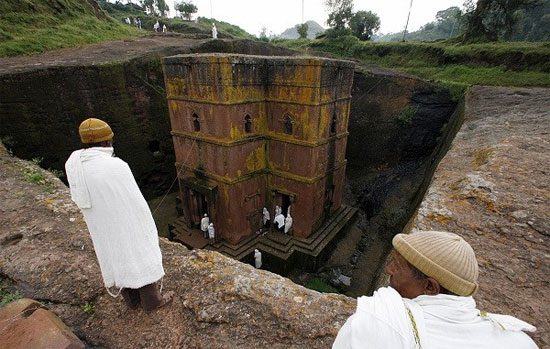
Church from Above.
Saint George is said to oversee the work of these angels. The legend suggests that the churches were carved over 24 years; however, archaeologists deem this impossible. Even today, completing such work using carbon steel chisels and diamond-tipped tools would be extraordinary. Moreover, there are many anomalies surrounding the construction of the complex. For instance, there should have been a significant amount of earth and rock removed from around and within the churches, but none can be found.
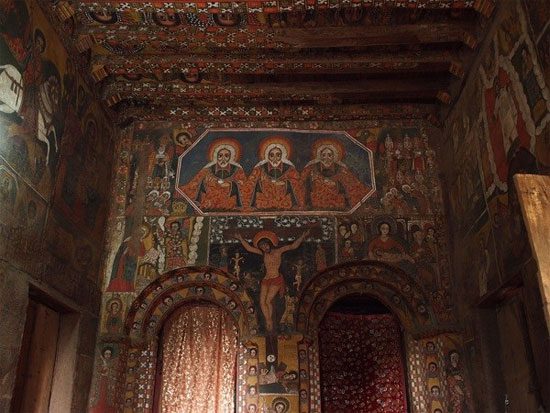
Intricate Interior Painting Patterns.
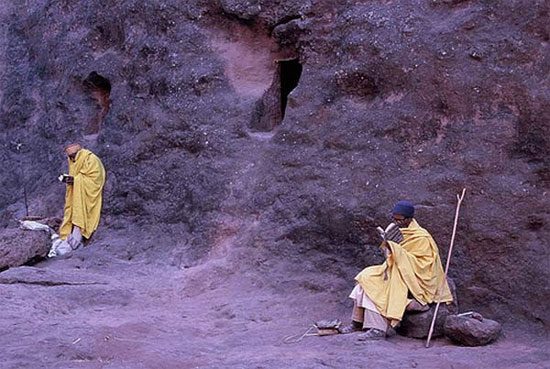
Pilgrims Gathering to Pray.
Constructed in a cross shape, with intricately carved windows, the church of St. George features a complex system of drainage ditches, tunnels, and underground structures within the rock. As the sun sets, the church glows pink, then shifts to gold and moss green before darkness envelops it.
Due to its impressive architecture and Christian influences, this church was designated a UNESCO World Heritage Site in 1978. Five years prior, UNESCO decided to erect protective coverings for part of this structure.
The rock-hewn churches of Lalibela have been managed by both the Church and the Ethiopian government for centuries. It is home to a community of priests and monks, making it a prominent pilgrimage site for many to celebrate the major holidays in the Ethiopian Christian calendar.





















































